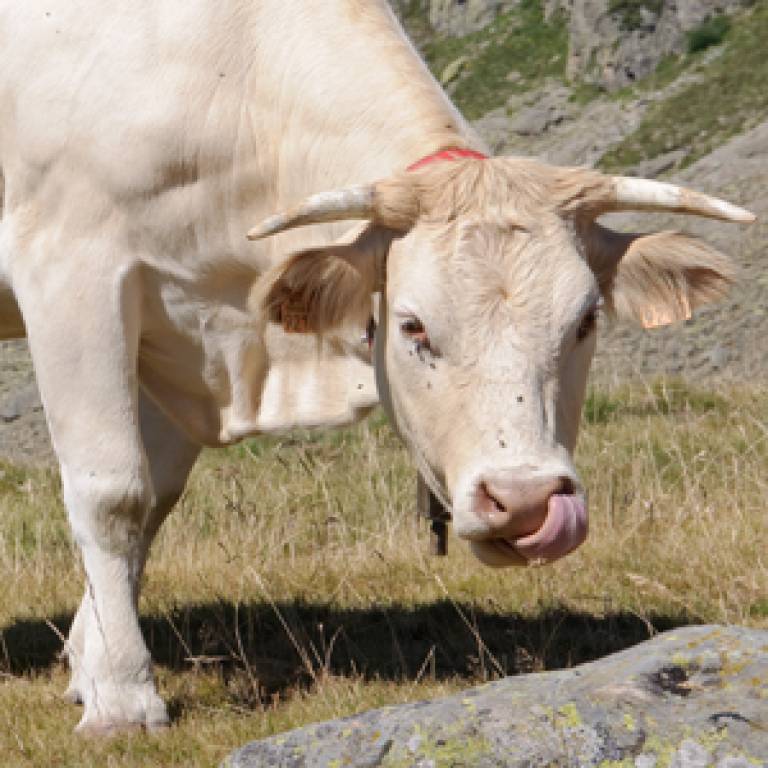What Animal Did The Cow Evolve From
All cattle are descended from as few equally 80 animals that were domesticated from wild ox in the Near East some 10,500 years ago, according to a new genetic written report.

An international squad of scientists from the CNRS and National Museum of Natural History in France, the University of Mainz in Frg, and UCL in the Britain were able to bear the study past get-go extracting Deoxyribonucleic acid from the bones of domestic cattle excavated in Iranian archaeological sites. These sites date to non long later on the invention of farming and are in the region where cattle were first domesticated.
The team examined how small-scale differences in the DNA sequences of those ancient cattle, too as cattle living today, could have arisen given dissimilar population histories. Using computer simulations they found that the Dna differences could simply have arisen if a modest number of animals, approximately fourscore, were domesticated from wild ox (aurochs).
The written report is published in the electric current issue of the journal Molecular Biology and Evolution.
Dr Ruth Bollongino of CNRS, France, and the Academy of Mainz, Germany; lead author of the study, said: "Getting reliable Deoxyribonucleic acid sequences from remains constitute in cold environments is routine.
"That is why mammoths were one of the first extinct species to have their DNA read. Just getting reliable DNA from basic constitute in hot regions is much more than difficult because temperature is then critical for DNA survival. This meant we had to be extremely conscientious that nosotros did not end up reading contaminating DNA sequences from living, or only recently dead cattle."
The number of animals domesticated has important implications for the archaeological written report of domestication.
We know from archaeological remains that the wild ancestors of modernistic-twenty-four hour period cattle, known as aurochs, were common throughout Asia and Europe, and then there would have been enough of opportunities to capture and domesticate them.
Prof Mark Thomas, geneticist and an writer of the report based at the UCL Research Department of Genetics, Evolution and Environment: "This is a surprisingly small number of cattle. We know from archaeological remains that the wild ancestors of modern-day cattle, known every bit aurochs, were common throughout Asia and Europe, so at that place would have been plenty of opportunities to capture and domesticate them."
Prof Joachim Burger, an author of the written report based at the Academy of Mainz, Germany, said: "Wild aurochs are very dissimilar beasts from mod domestic cattle.
"They were much bigger than modern cattle, and wouldn't have had the domestic traits we see today, such as docility. So capturing these animals in the get-go place would not have been easy, and fifty-fifty if some people did manage snare them alive, their continued direction and breeding would still have presented considerable challenges until they had been bred for smaller size and more than docile behaviour."
Archaeological studies on the number and size of prehistoric beast bone take shown that non simply cattle, but likewise goats, sheep and pigs were all first domesticated in the Near E. Simply saying how many animals were domesticated for any of those species is a much harder question to answer. Classical techniques in archaeology cannot give united states the whole picture, but genetics tin help - especially if some of the genetic data comes from early domestic animals.
Dr Jean-Denis Vigne, a CNRS bio-archaeologist and author on the report, said: "In this written report genetic analysis allowed united states to reply questions that - until now -archaeologists would not even effort to address.
"A small number of cattle progenitors is consistent with the restricted area for which archaeologists have evidence for early cattle domestication ca. x,500 years ago. This restricted area could be explained by the fact that cattle breeding, contrary to, for instance, caprine animal herding, would have been very difficult for mobile societies, and that just some of them were really sedentary at that time in the Almost Due east."
Dr Marjan Mashkour, a CNRS Archaeologist working in the Heart East added "This study highlights how important information technology tin be to consider archaeological remains from less well-studied regions, such as Iran. Without our Iranian data it would have been very difficult to draw our conclusions, even though they concern cattle at a global scale."
Epitome: Blond d'Aquitaine on a mountain pasture. Source: Wikimedia
Media contact: Clare Ryan
Links:
UCL Research Department of Genetics, Development & Environment
Research in the periodical of Molecular Biological science and Evolution
Source: https://www.ucl.ac.uk/news/2012/mar/dna-traces-cattle-back-small-herd-domesticated-around-10500-years-ago
Posted by: hardertraturness.blogspot.com

0 Response to "What Animal Did The Cow Evolve From"
Post a Comment